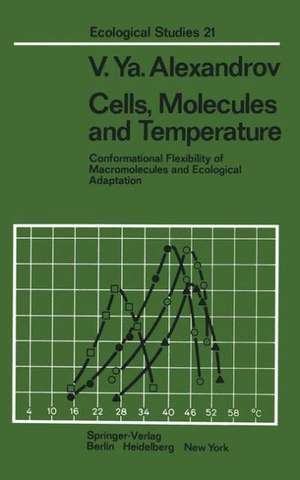Cells, Molecules and Temperature: Conformational Flexibility of Macromolecules and Ecological Adaptation: Ecological Studies, cartea 21
Autor Vladimir Ya. Alexandrov Traducere de V. A. Bernstamen Limba Engleză Paperback – 12 feb 2012
Din seria Ecological Studies
- 18%
 Preț: 1118.93 lei
Preț: 1118.93 lei -
 Preț: 553.72 lei
Preț: 553.72 lei - 18%
 Preț: 1680.55 lei
Preț: 1680.55 lei - 18%
 Preț: 1003.38 lei
Preț: 1003.38 lei - 20%
 Preț: 1004.71 lei
Preț: 1004.71 lei -
 Preț: 480.62 lei
Preț: 480.62 lei - 5%
 Preț: 752.26 lei
Preț: 752.26 lei - 15%
 Preț: 643.99 lei
Preț: 643.99 lei - 15%
 Preț: 644.18 lei
Preț: 644.18 lei - 15%
 Preț: 652.49 lei
Preț: 652.49 lei - 18%
 Preț: 789.83 lei
Preț: 789.83 lei -
 Preț: 382.36 lei
Preț: 382.36 lei - 15%
 Preț: 643.48 lei
Preț: 643.48 lei - 15%
 Preț: 646.30 lei
Preț: 646.30 lei - 15%
 Preț: 634.32 lei
Preț: 634.32 lei -
 Preț: 384.86 lei
Preț: 384.86 lei - 18%
 Preț: 789.98 lei
Preț: 789.98 lei - 15%
 Preț: 645.14 lei
Preț: 645.14 lei - 15%
 Preț: 649.39 lei
Preț: 649.39 lei - 18%
 Preț: 1005.43 lei
Preț: 1005.43 lei - 18%
 Preț: 949.23 lei
Preț: 949.23 lei - 15%
 Preț: 649.54 lei
Preț: 649.54 lei - 15%
 Preț: 643.34 lei
Preț: 643.34 lei - 15%
 Preț: 649.71 lei
Preț: 649.71 lei - 15%
 Preț: 638.76 lei
Preț: 638.76 lei - 18%
 Preț: 957.62 lei
Preț: 957.62 lei - 18%
 Preț: 1235.25 lei
Preț: 1235.25 lei - 18%
 Preț: 962.18 lei
Preț: 962.18 lei - 18%
 Preț: 949.23 lei
Preț: 949.23 lei - 15%
 Preț: 660.68 lei
Preț: 660.68 lei -
 Preț: 397.76 lei
Preț: 397.76 lei - 15%
 Preț: 638.24 lei
Preț: 638.24 lei - 18%
 Preț: 942.31 lei
Preț: 942.31 lei - 18%
 Preț: 1232.57 lei
Preț: 1232.57 lei - 15%
 Preț: 651.34 lei
Preț: 651.34 lei - 18%
 Preț: 952.72 lei
Preț: 952.72 lei - 18%
 Preț: 1834.27 lei
Preț: 1834.27 lei - 18%
 Preț: 1229.10 lei
Preț: 1229.10 lei -
 Preț: 423.95 lei
Preț: 423.95 lei - 18%
 Preț: 948.92 lei
Preț: 948.92 lei
Preț: 566.70 lei
Preț vechi: 708.37 lei
-20% Nou
Puncte Express: 850
Preț estimativ în valută:
108.44€ • 118.16$ • 91.37£
108.44€ • 118.16$ • 91.37£
Carte tipărită la comandă
Livrare economică 19-25 aprilie
Preluare comenzi: 021 569.72.76
Specificații
ISBN-13: 9783642665431
ISBN-10: 3642665438
Pagini: 348
Ilustrații: XII, 330 p.
Dimensiuni: 156 x 244 x 18 mm
Ediția:Softcover reprint of the original 1st ed. 1977
Editura: Springer Berlin, Heidelberg
Colecția Springer
Seria Ecological Studies
Locul publicării:Berlin, Heidelberg, Germany
ISBN-10: 3642665438
Pagini: 348
Ilustrații: XII, 330 p.
Dimensiuni: 156 x 244 x 18 mm
Ediția:Softcover reprint of the original 1st ed. 1977
Editura: Springer Berlin, Heidelberg
Colecția Springer
Seria Ecological Studies
Locul publicării:Berlin, Heidelberg, Germany
Public țintă
ResearchCuprins
1. Modificational Changes of the Primary Thermoresistance of Cells.- 1.1 The Primary Thermoresistance of Cells.- 1.2 The Level of Primary Thermostability of Cells and Habitat Temperature.- 1.3 Changes in the Cellular Primary Thermostability Produced by Non-Temperature Factors.- 2. Genotypic Changes of the Primary Thermoresistance of Cells.- 2.1 Animals.- 2.2 Plants.- 2.3 Microorganisms.- Summary.- 3. Variations in Thermostability of Protoplasmic Proteins as a Basis for Changes in the Level of Primary Cellular Thermoresistance.- 3.1 Are the Shifts in Cellular Thermoresistance Accompanied by Alteration of the Cellular Resistance to Other Injurious Agents ?.- 3.2 Changes in Protein Thermostability Caused by Isolation of the Proteins From Cells.- 4. Adaptive Modifications of Conformational Flexibility of Macromolecules as a Basis for Changes of the Protein Thermostability.- 4.1 The Correlation Between Thermostability of Proteins and the Environmental Temperature Conditions of a Species’ Life Cannot be Explained by an Adaptive Significance of the Level of Thermostability.- 4.2 A Hypothesis of the Adaptive Significance of a Correspondence of the Conformational Flexibility Level of the Protein Molecules to the Environmental Temperature Conditions of Species’ Life.- 4.3 The Level of Conformational Flexibility of Protein Molecules and Their Resistance to Non-Thermal Agents.- 5. The Plausible Points of Application of the Natural Selection During Alteration of a Correspondence Between the Level of Conformational Flexibility of Protein Molecules and the Temperature Ecology of a Species.- 5.1 Activation Energy.- 5.2 Affinity of Enzymes to Substrates, the Michaelis Constant.- 5.3 A Temperature Optimum for Enzyme Activity.- Summary.- 5.4 Lifetime of Proteins in the Cell.-Summary.- 6. Plausible Mechanisms of Regulation of the Level of Conformational Flexibility of Proteins.- 6.1 Modificational Changes of the Conformational Flexibility of Protein Macromolecules.- 6.2 Genotypic Changes of the Conformational Flexibility of Protein Molecules.- 7. Thermostability of Nucleic Acids and the Temperature Environment of Species’ Life.- Summary.- 8. Saturation of Fatty Acids and the Temperature Conditions of Life.- Summary.- Epilogue.- References.













